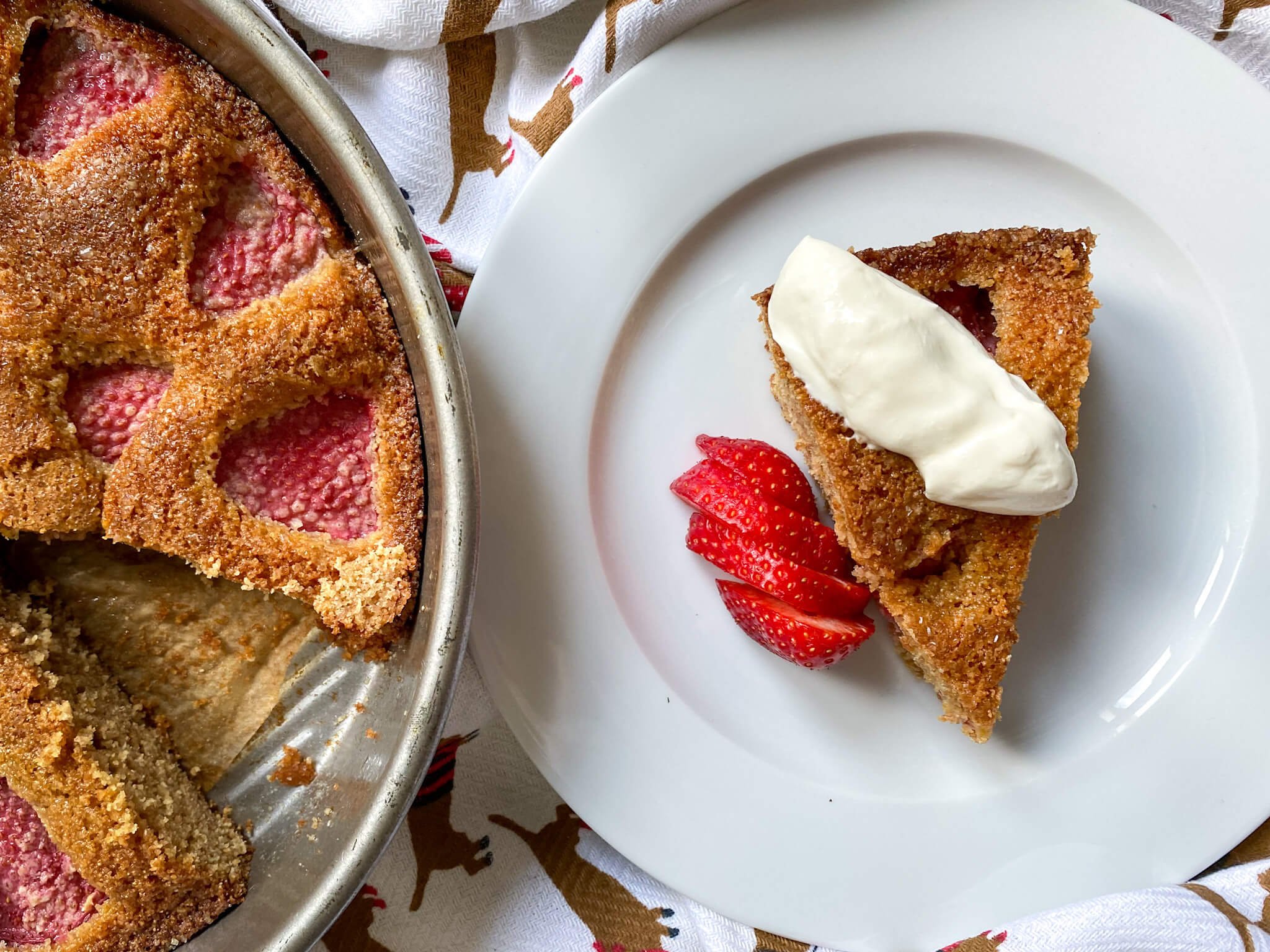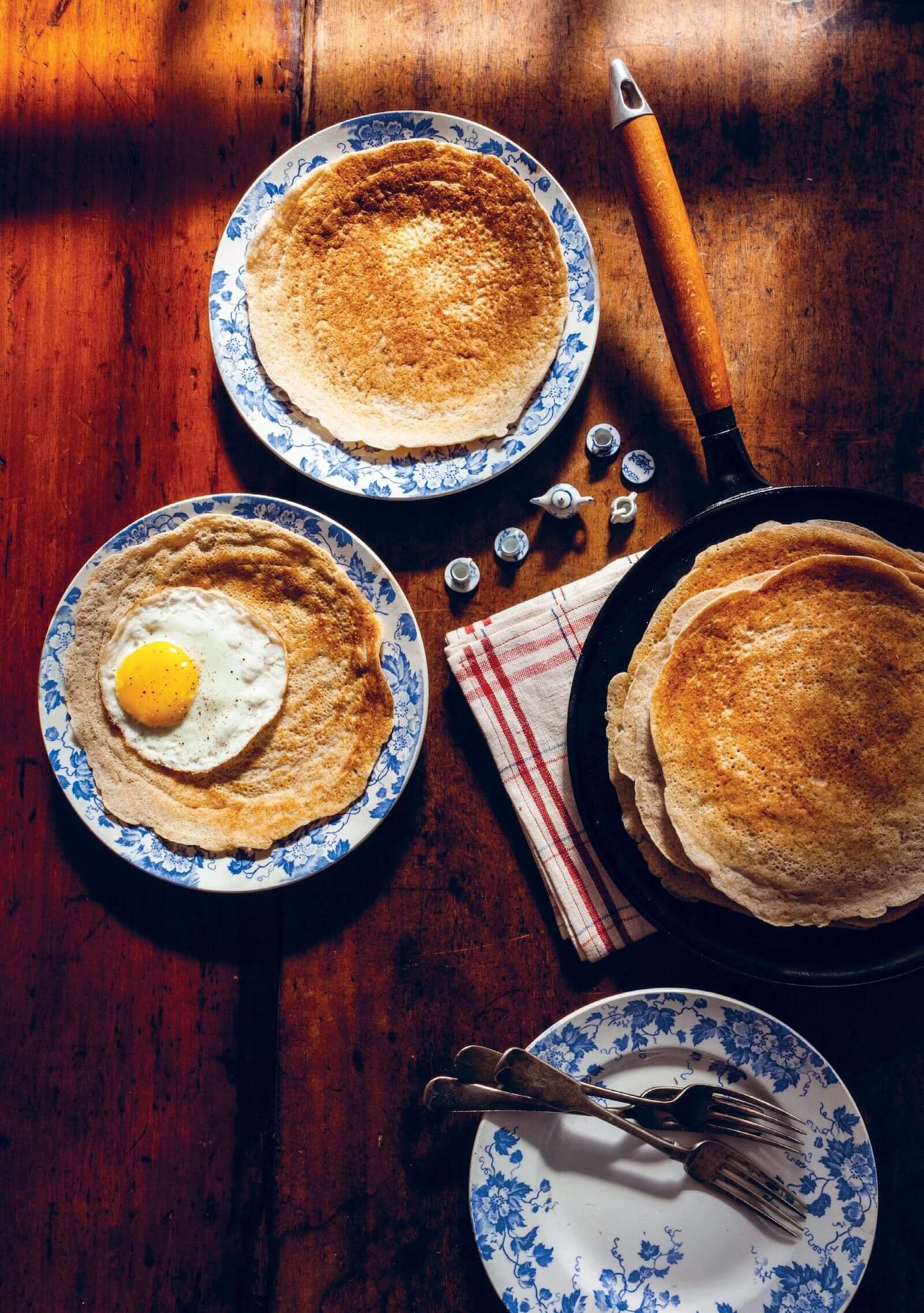Consuming Passions: Spelt
Spelt Strawberry Torte, one of Shikha’s own creations
Shikha Kaiwar is a pastry chef and writer of the Shikha la Mode newsletter. She’s been baking with spelt since the beginning of her career and her desserts often feature this ancient grain. Her piece helps demystify spelt so that other cooks can confidently use it to create more complex, flavourful baked goods.
At the first restaurant I ever worked at, one of our signature desserts was a simple one—a plate of assorted cookies, served with an espresso after the meal. To elevate these cookies from their everyday status, we baked them not with white flour but with whole grains from around the world—teff, buckwheat, rye, khorasan. Each cookie took on a life of its own, surprising and sometimes frustrating diners who wanted a familiar taste. But with each plate served, there was one cookie that consistently stood out from the rest—the one made with spelt. As I moved on to other restaurants, as cooks are wont to do, I took the magic of spelt with me, baking everything from snack cakes to tart crusts to yes, cookies. Spelt has changed the way I bake.
Spelt is one of the oldest grains in the world. The historical record shows evidence of its use in Mesopotamia up to nine thousand years ago, and there are several references to it in the Bible. As part of the “ancient grain” family, spelt, like its relatives, has not been genetically modified for mass commercialisation. As a result, it is a hearty grain packed with health benefits. Compared to white flour, spelt contains more protein and fiber, as well as nearly a full day’s serving of manganese, a mineral essential for bone health. Spelt also provides twenty to thirty percent of the daily value for iron, magnesium, and zinc. As someone who suffers from chronic iron deficiency, spelt has become a staple grain in my household with which I can easily add extra nutrients into my desserts.
Spelt is a type of wheat, so while it does contain gluten, it is much milder due to the lack of genetic modification. This makes foods made with spelt much easier to digest and even permissible for some people who have sensitivities to traditional gluten from white flour. That said, if you are gluten-intolerant please check with your doctor before consuming spelt, just to be safe.
When milled into flour, white spelt flour has nearly the same texture as plain white flour, as both are made using only the starchy endosperm. This makes white spelt flour ideal for baking pastries such as cakes, cookies, and scones. For those of you new to spelt, you don’t have to change the way you bake. Simply swap out some or even all the plain white flour for white spelt flour and you can create a baked good with the same softness and moistness you crave while achieving a far superior flavor profile.
If you’re nervous about swapping white flour for spelt flour entirely, then start by going half and half. I enjoy this fig and apricot tart that does a nice job of incorporating spelt so that it is easy to taste without straying too far from the familiar. A 50-50 ratio creates a tart crust that’s a tad darker due to the natural coloring of spelt and has a slightly nuttier flavor—a wonderful contrast to the soft, almond cream filling. The next time you make it, you can make a tart crust that is 100 percent spelt and marvel at the complexity this grain adds.
Cookies, as I mentioned at the beginning, are an obvious choice for spelt. I particularly enjoy using spelt in cookies that are naturally meant to be heartier, such as chocolate chip, ginger-molasses, and these digestives by Regula Ysewijn. Given the high fiber content in spelt, one can be sure that a spelt digestive will indeed aid in digestion! Spelt’s gluten content lends itself to a chewier cookie as well; just make sure to chill your dough for at least an hour before baking it. I prefer to keep my cookie dough in the fridge overnight, splitting up the recipe into two days when I am pressed for time. The resulting cookies have a deeper, richer flavor that white flour simply cannot provide.
One of my favorite ways to use spelt is for all things breakfast. It adds an instant taste lift to any dish without weighing it down, as other whole grains are guilty of doing. And who wouldn’t want their first meal to be full of nutrients, and therefore more energy to conquer the day with? I love these wild garlic and cheddar scones by Ruth Nieman, where the spelt stands up to the heartiness of the cheese and skips along with the garlic nicely. It’s also a good reminder that spelt isn’t naturally sweet so it can be used in both sweet or savory applications.
Another great example of spelt in a savory context is this recipe for Staffordshire oatcakes. They remind me of American pancakes, which as an American myself, is one way I typically use spelt in my own household. But oatcakes are even more versatile, and can be a vehicle for eggs and bacon or jam and butter. Spelt oatcakes are stronger so they hold up to anything you might decide to add to them. And if you are new to spelt, oatcakes (or pancakes) are a good gateway into using wholemeal spelt instead of white spelt, for added nutrients.
Wholemeal spelt, like other wholemeal flours, uses the entire grain, which makes baked goods more dense and more nutritionally beneficial. This type of spelt absorbs more liquid, so if you use it in baking, you will have to increase the liquid measurement in your recipe. As each recipe is different, there is no golden ratio on how much more liquid you need to add, but you can put on your chef’s hat and experiment to find out what works for you. Why not try substituting wholemeal spelt into a recipe on ckbk and post a review to share how it works out.
In the meantime, there are loads of recipes for multigrain bread, sourdough bread, and even baguettes for you to try your hand at baking with wholemeal spelt. These recipes use a combination of spelt and other flours to create some wonderful breads that can be eaten at breakfast, as a snack, or whenever you please. And if you’re familiar with bread baking, you’ll know that the ingredients may behave slightly differently each time due to the humidity of your kitchen and the season. Baking bread is not just about the recipe but also about understanding and trusting the process, which admittedly, even I need practice with.
Spelt is a versatile, delicious grain that levels up your baking, no matter what you’re making. My main advice when using it is to not shy away from its flavor! It is readily available at most grocery stores (in the UK, I tend to prefer the Doves Farm spelt flour), so get yourself a bag and see the difference for yourself.
A selection of recipes on ckbk using spelt
INSTRUCTIONS
Try Shikha’s own recipe for Spelt Oatmeal Almond Butter Muffins
Makes 15 muffins.
METHOD
Preheat the oven to 400ºF. Spray two standard-sized muffin trays and set aside.
In a small bowl, combine the oats and milk and set aside while you're doing everything else.
In another medium bowl, whisk together the spelt, baking powder, cinnamon, ginger and salt and set aside.
In a large bowl, whisk together the melted butter, oil, almond butter, vanilla, eggs, and honey until smooth. Whisk in the oats/milk mixture.
Dump in all the flour mixture at once, and whisk until combined.
Scoop into muffin tins, filling each tin three-quarters full. Sprinkle with your topping of choice—plum slices, cocoa nibs, coconut flakes, or sprinkles.
Bake until a toothpick inserted into the center comes out clean, around 15 minutes. Cool muffins on a wire rack that's set on the counter, NOT on top of the oven. Let cool for at least 10 minutes. Enjoy warm or at room temperature.
Store in an airtight container or ziploc bag in the fridge for up to 1 week, or in the freezer for up to 3 months.
INGREDIENTS
130 grams (1.5 cups) rolled oats
240 grams (1 cup) whole milk (or dairy-free alternative)
120 grams (1 cup) spelt (can use whole-wheat or AP flour)
2 teaspoons baking powder
1 teaspoon cinnamon
1/4 teaspoon ground ginger
1/4 teaspoon salt
1/2 stick (56g) unsalted butter, melted
55 grams (1/4 cup) almond oil (or canola oil)
120 grams (1/2 cup) crunchy almond butter
2 teaspoons vanilla
2 large eggs, room temp
170 grams (1/2 cup) honey
Sliced plums, unsweetened coconut flakes, cocoa nibs, and sprinkles, for topping
More Consuming Passions
Di Murrell enjoys the many delicious uses for the humble fish, whether fresh or tinned
Chris Bulow, creator of the website Salute the Pig, on the joys of all things porcine.
Omani food writer Dina Macki, known as The Pomegranate Queen on Instagram, celebrates her favorite fruit










